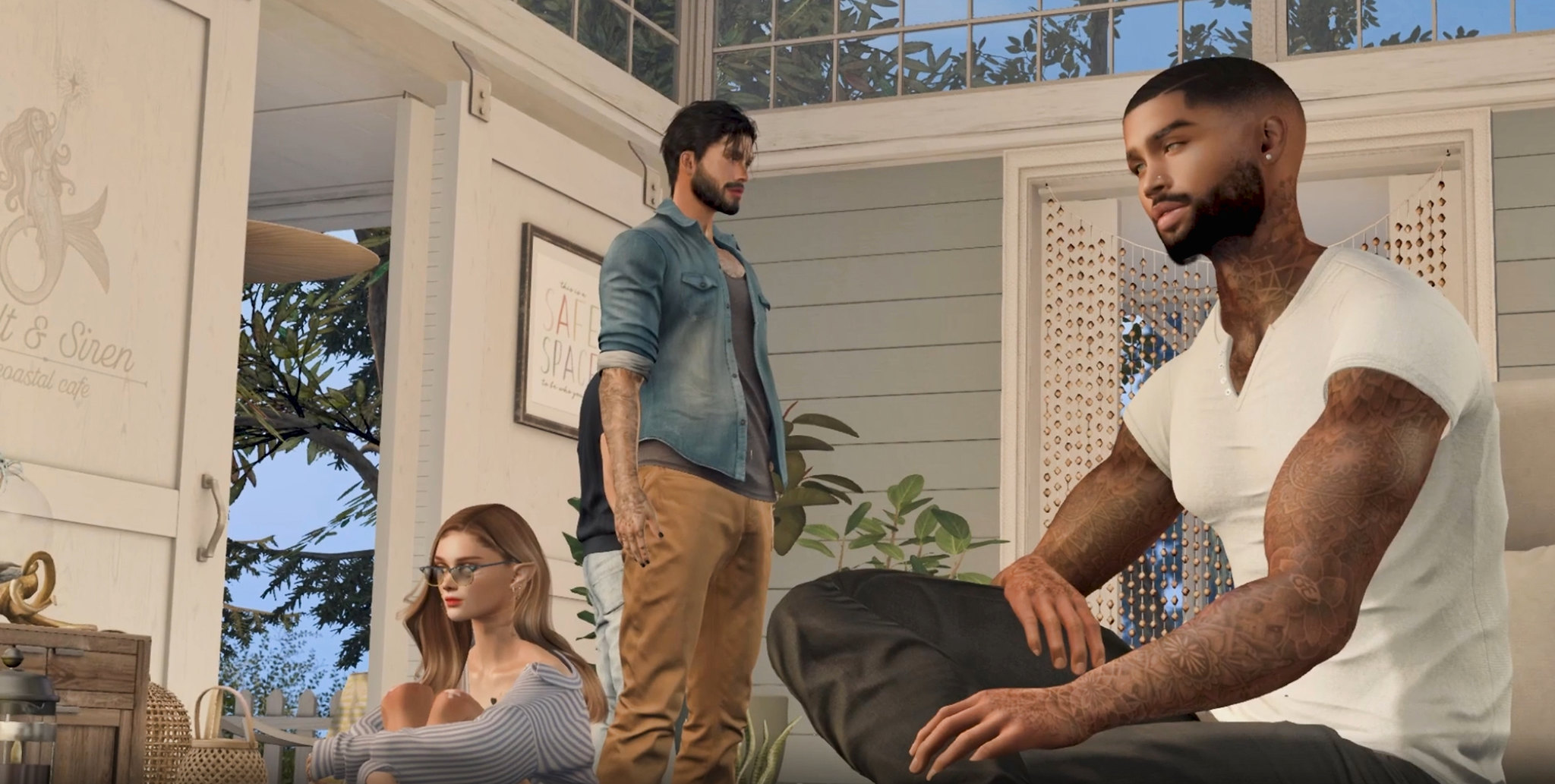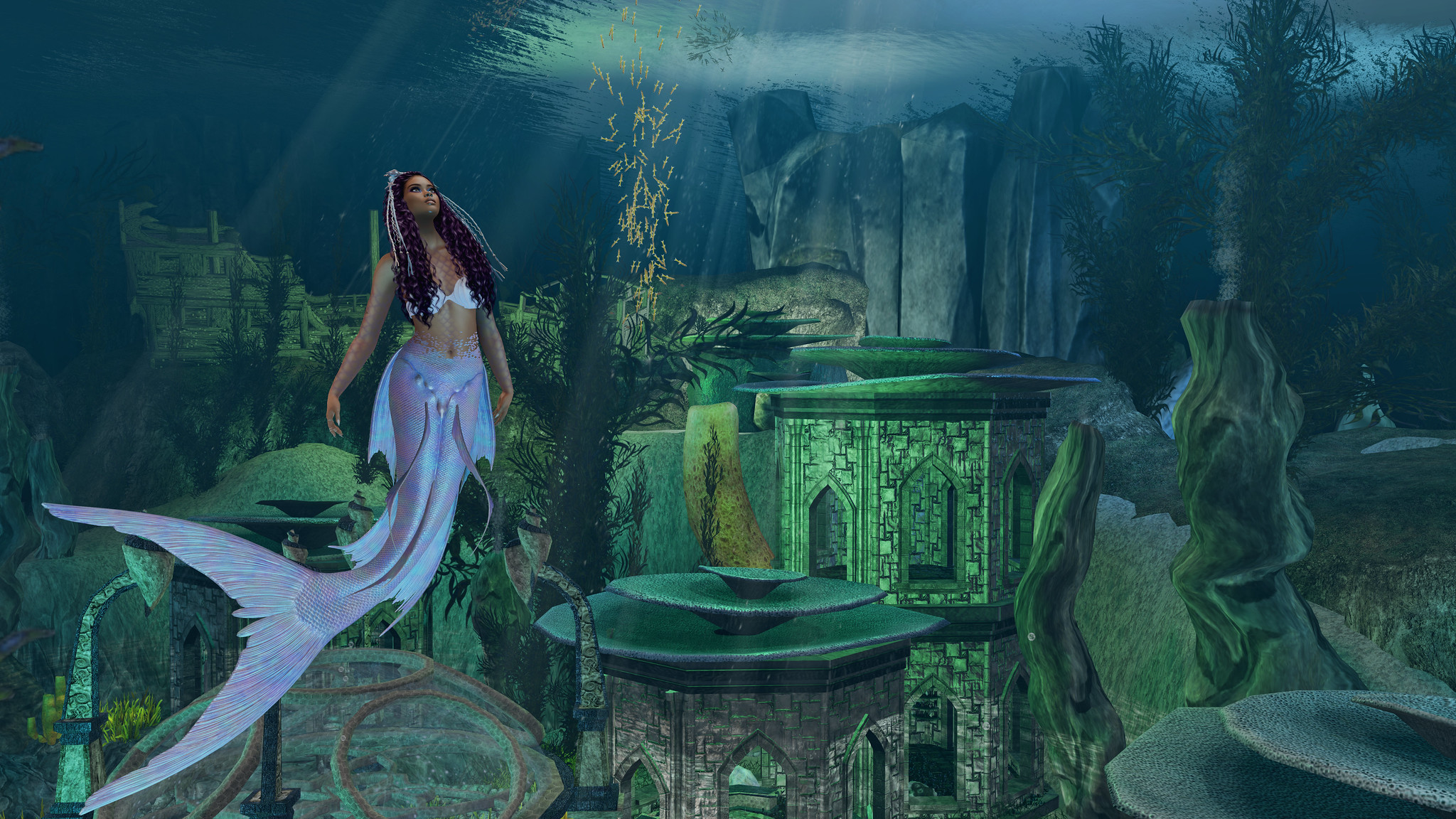Everything, Everywhere: The wildly surreal film that captured our own unreality
The film that dominated at the Oscars touched a nerve with generations that spend much of their time in online 'non-spaces', flitting between multiple realities and timelines, yearning for an escape.
"I Want to Spend the Rest of My Life Everywhere, with Everyone, One to One, Always, Forever, Now" - Damien Hirst, 1997.
Sometime before the pandemic, I bought a copy of Wendell Berry’s 1987 essay “Why I am not going to buy a computer” from a museum shop in Stockholm. I can’t remember what drew me to it. Perhaps its audacity. “Do I wish to keep up with the times? No” simply reads the front-page, before Berry launches an uncompromising polemic, lambasting the effects of automation on our lives. “If the use of a computer is a new idea, then a newer idea is not to use one.”
I think about Berry’s essay often, when waiting for my computer to load, typing messages to customer service chat-bots or navigating puzzles to prove I am human. Most recently I thought about it when reading Roisin Kiberd describe that she “had spent more time with my laptop than with any living being on earth.” It is easy to find oneself in Kiberd’s description. I have spent hours with my own computer; it has worked with me, discovered with me, sat with me in almost every domain of life. So pervasive is modern technology that Kiberd’s comments feel almost unremarkable compared to Berry’s seemingly eccentric stance. An apparent acceptance that one’s refusal to use technology has become more outlandish than embracing it as our closest companion.
In a 2017 essay for The Atlantic, Leslie Jamison profiles Second Life, an early virtual role-playing world first launched in 2003 and still operating today. Profiling counter-cultural characters shapeshifting between distanced, unfamiliar environments, the essay explores life in a multiverse of the kind now dominating blockbuster cinema - like the Oscar dominating Everything Everywhere All At Once. There is a young mother dating online, a peer group of disabled users excluded from the physical world and a closeted transgender woman living her identified gender within the platform. The tone of Jamison’s essay isn’t quite one of bemusement, but at least part of its appeal was Second Life’s other-like status at the time of its publication.

(Credit: Second Life)
Only five years later, the essay’s pull is its deep familiarity, its description of a future that quietly arrived. The office transitioned to Zoom, Slack and Microsoft Teams, while our social lives retreated into the worlds of WhatsApp, Instagram and Twitter. We find ourselves working, shopping, banking, playing and dating online. We catch up with family online. We meet our future spouses online. In Jamison’s essay, Philip Rosedale, the founder of Second Life, predicted the real world would become non-essential to daily life. An “archaic, lovable place”, he forecasts, like a “kind of museum or theatre” to be used for quaint recreation, rather than hosting the continuity of our daily existence.
Today, time spent ‘offline’ possesses an almost liminal quality. When not prompted by notifications demanding we flit between social media interactions, parallel conversations, breaking news and work emails, we find ourselves frequently checking for them, yearning back into the digital world. As the sociologist Sherry Turkle notes, “the world of devices [allows us to] bail out of the physically real at any time, to go to all the other places we have available to us”. Technology even has its own lexicon of geography. We visit websites, platforms and domain names, to join meetings where we may periodically enter breakout rooms. It was only after a year of joining video-calls that I realised I wasn’t remembering these “meetings” in the location from which I was sat, but that my memory had created an entire category of space they inhabited. Virtual meeting rooms provided the familiarity and hallmarks of a place that never physically existed; harbouring visual, sonic and social characteristics entirely divorced from physical reality.
These online spaces remind me of what anthropologist Marc Augé calls “non-places”, super-modern environments which lack a rooted sense of relations, history or identity. Exemplified by bland, identikit shopping malls, transport hubs or hotel chains, non-places are characterised by insipidity, anonymity and pre-planned structure. Is this not the perfect description for life online, in which we raise ‘tickets’ with automated customer service systems and switch between video-calls? Like, Retweet, Swipe, Reply. We interact through pre-formatted actions, navigating environments which can be exited at the click of a button. If Twitter is a town square, as Elon Musk recently declared, it is an unsettling unique one: unconditionally functional, devoid of heritage or tradition, adapting at the behest of a developer’s code with an almost solipsistic ephemerality.
Aren’t we all exhausted in the meta-verse? That the film was the first unexpected success of the COVID era - a time of unprecedented online engagement – feels like no coincidence.
The artist Cécile B. Evans likens our virtual spaces to the communal social housing complexes built throughout the 20th century. They quote Le Corbusier, the pioneer of modern brutalist architecture, who aspired to “bring the basic pleasure of life: to be free” by “creating well-ordered living quarters capable not only of containing the people that live in them, but also of retaining them”. The architect’s motivation was to construct “interconnected communities, within which all areas of life could be addressed”. The idealism of Le Corbusier now echoes in the words of Mark Zuckerberg: “Facebook was built to accomplish a social mission - to make the world more open and connected… when people are connected, we can do some great things… access jobs, education, health, communications… we are trying to build a community”. Or Jack Dorsey, founder of Twitter: “I love cities. Going into public office, I could help write laws and see the effect within eight years. Whereas with programming I could model similar laws, policies, rules, and see the effect immediately. [I] can change things quicker than ever was possible”.

(Credit: Second Life)
What our modern-day digital architects share with their brutalist-era counterparts, Evans argues, is “elite projection” – the belief that what an influential few find convenient or attractive is good for society as a whole. Predictably, this ends in depravity. Just as the purpose-built, brutalist complexes of the 20th century fell victim to vandalism, piled garbage and abandonment by law enforcement, today’s online non-places ebb into difficult-to-police harbours of trolling, antisocial behaviour and abuse. Carefully planned idealism descends into a chaotic metropolis.
There is a sense of this chaotic, shifting depravity in the opening scenes of Everything, Everywhere All At Once, released in March 2022 and easily the most acclaimed film of this year’s Oscars. The viewer finds themselves trying to orientate a world governed by rapidly changing laws, through which characters adopt a series of bizarre and bewildering transitions. A tax auditor morphs into a professional wrestler, a martial arts sequence dominates an office, characters’ fingers transform into sausages; all interspersed with jocose gore, creating a synthetic, video game-like aesthetic and pacing. This jumbled series of surrealist vignettes, seemingly lacking curation, is united only in its ability to inspire our most primitive responses: comedy, action, suspense, disgust. A fight scene descends into glitter, a character rubs hand-sanitiser into their eyes, blood transforms into ketchup. It’s TikTok, for the big screen. Unsurprisingly, the engineers of this ‘verse-jumping’ are soon revealed to be three mavericks sat at computers, wearing virtual-reality-like headsets, typing lines of code.
These hyper-real archetypes of the attention economy pervade the film. An early scene features the lead character daydreaming between universes via a Bluetooth headset. “Mrs Wang, are you with us?” she is asked, “I know you have a lot of things on your mind”. Meanwhile, we are told the violent, destructive nihilism of the film’s antihero, Joy, is forged from the “fracturing” of her mind through constant exposure to multiple parallel universes. Despite her callousness, Joy is a strangely compelling character, perhaps because we recognise her besieged, fragmented attention within ourselves. “I’m tired,” Joy admits in perhaps the most memorable scene of the film, followed by a montage of the multiverses she’s been inhabiting.
Paralysed by endless possibility and constant comparison to uncanny avatars, we are left with a melancholic search for meaning so profound it can be difficult to imagine a future.
Aren’t we all exhausted in the meta-verse? That the film was the first unexpected success of the COVID era - a time of unprecedented online engagement – feels like no coincidence. Through immersive, disorientating scenarios superimposed upon a family’s tax affairs, the film offers a surrealist representation of our own experience during lockdown. Lives transitioned online against a backdrop of real-world banality, the physical world relegated to a government-allotted walk per day - a place for “quaint recreation”, as Philip Rosedale had predicted. A colleague of mine feared they were developing dementia during this period, before recognising their experience as the consequence of endlessly transitioning between online meetings, their “extended mind” collapsing in on a digital multi-verse of its own. Everything Everywhere All At Once illuminates this disorientation; it probes our unease.
In virtual spaces, we exist within a kind of “mediated presence”, and when we do communicate, we do so with a lag. Sherry Turkle recalls meeting young people terrified of real-time encounters. “When you text, you have more time to think about what you’re writing, on the telephone too much might show” one man tells her. Whether it’s the moment’s pause while drafting a WhatsApp message, or the ever-present reflected webcam feed of ourselves, our constant embodiment of third-person avatars habituates a need to check ourselves in every interaction. Existing in a world of black mirrors, we become paralysed observers of our uncanny profiles, while our thoughtlessness is replaced by an excessive mentalisation. Hyper-aware and hyper-reflective, this disembodied presence fuels the crises typically characteristic of adolescent development: searching for identity amid confusion, intimacy amid isolation.
All the while, the timelessness of the internet robs us of the cultural vehicles traditionally relied on to progress through adolescence. Everything exists everywhere online, all at once. Instead of television, film or music following broadcast or release schedules, we pick content from seemingly static online catalogues, according to our own atomised timeline: yhe cultural output of our parents’ generation is enmeshed alongside today’s releases, leaving us as likely to discover generational re-runs of Friends or New Wave as any collective generational discovery.
This montaging of cultural and personal eras contributes to what Mark Fisher calls a “flattening sense of time. The internet has altered the texture of everyday experience beyond all recognition” he writes, “culture has lost the ability to articulate the present.”
Or, as Fisher goes on to describe, “it could be that there is no present to articulate anymore.” Whereas a fifteen-year period once contained the Beatles’ first album through to the start of Punk, or from Punk to Jungle, today it has an atemporal quality. The result is a slowing of culture, derailed by a lack of disjuncture between cultural movements. Deprived of a genuine sense of novelty or modernity, any generational independence through which we might collectively learn to explore and navigate the world is lost. The escapist temporal objectivity of the internet is alluring, but - running contrary to subjective human experience - it can also be profoundly disorientating, rife for nihilism and passivity. Unable to embrace futurity or rebel against tradition, we experience the “slow cancellation of the future”, stuck in eternal adolescence, existing among generational fragments of non-time. How do we sublimate an identity amid timelessness? And what for narrative, agency and personhood?
Queue Joy, the pained teenage antihero of Everything Everywhere All at Once, representing this dramatic tension, grappling with a search for meaning amid omniscient nihilism. Her anger - almost exclusively directed towards her mother – embodies a child’s attitude towards a neglectful parent: ‘I hate you, don’t leave me’. The film is about generational distance, not feeling understood, struggling to balance agency with belonging. Of being a “digital native subject to a violent removal from the habits of their parents” as Michael Harris writes, “a shift that will leave them quite alien to those only one generation older”. In other words, Everything Everywhere All at Once is a coming-of-age film, for the internet generation.
The finale of the film hinges on Evelyn and Joy’s rejection of this seductive control. They learn to find stability in the unpredictability of human relationships, finding trust in companionship.
Like the cultural aesthetics of yesteryear that haunt modern culture, both Joy and her mother are saturated with regret for missed opportunities throughout the film. Evelyn’s thoughts are punctuated by comparisons with multiverses offering brighter, happier, more successful narratives. “You have so many goals you never finished, dreams you never followed, you’re living your worst you,” she is told. “Can’t you see? Every failure branched off into a success for another Eveyln, in another life”. This evokes what Fisher describes as “hauntology,” a sense of being haunted by “spectres of lost futures [we] were trained to expect, but which never materialized”. The presence of these cultural and personal lost futures contributes to the latent sense of inadequacy experienced by the internet generation. Paralysed by endless possibility and constant comparison to uncanny avatars, we are left with a melancholic search for meaning so profound it can be difficult to imagine a future. “Everything we do gets washed away in a sea of every other possibility,” Joy tells us, “if nothing matters, then all the pain and guilt you feel for making nothing of your life goes away”.
By the same token, Evelyn’s daughter Joy is a character trying to regain much-needed control amid a world which convincingly, but wrongly, leads her to believe it’s possible. Seduced by vignettes where she defies natural and physical laws, Joy interacts with multiverse representations of her family, akin to how we engage in virtual environments. Conversations we determine the pace of, avatars we project onto, social relationships we exert control over. These virtual interactions, and our mediated presence within them, transform relations into what Heinz Kohut describes as self-objects - internalised representations of external beings, which are experienced as part of the self. The problem with these controlled relations, Sherry Turkle suggests, is that they do “not teach us how to be with people… digital connections offer the illusion of companionship without the demands of friendship”. “We are lonely, but fearful of intimacy,” Turkle writes, portending Joy’s existential struggle. The trade-off for this solipsistic existence is aloneness; the paradox of limitless personalisation is that we have nobody to actually share it with.
The finale of the film hinges on Evelyn and Joy’s rejection of this seductive control. They learn to find stability in the unpredictability of human relationships, finding trust in companionship. “No matter what, I still want to be here with you, I will always, always, want to be here with you,” Evelyn tells her daughter. The film’s conclusion is about disavowing nihilism, yes, but also repudiating the teenage neuroticism which fuels it. It champions acceptance rather than limitless possibility; preservation rather than progress; belonging rather than unrestrained freedom. As Joy finds meaning in an imperfect world, the illusory control of an escapist multiverse becomes redundant. The viewer, having compelled the film to slow down, finds relief in its conclusion. We learn we don’t want Everything, Everywhere, All At Once. We just want to make sense of it.
The Lead is now on Substack.
Become a Member, and get our most groundbreaking content first. Become a Founder, and join the newsroom’s internal conversation - meet the writers, the editors and more.





